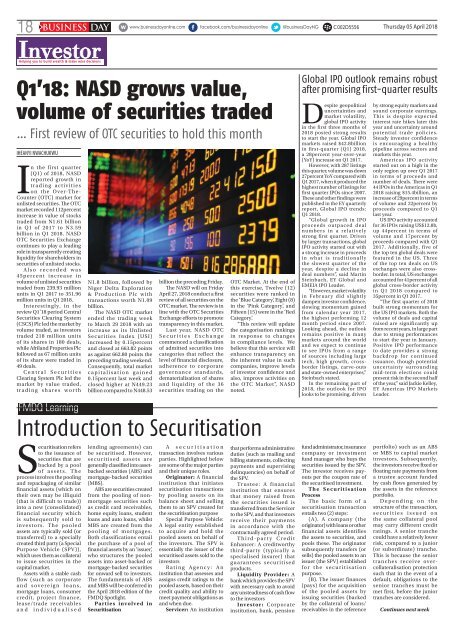BusinessDay 05 Apr 2018
Create successful ePaper yourself
Turn your PDF publications into a flip-book with our unique Google optimized e-Paper software.
Thursday <strong>05</strong> <strong>Apr</strong>il <strong>2018</strong><br />
18 BUSINESS DAY<br />
C002D5556<br />
Investor<br />
Helping you to build wealth & make wise decisions<br />
Q1’18: NASD grows value,<br />
volume of securities traded<br />
… First review of OTC securities to hold this month<br />
IHEANYI NWACHUKWU<br />
In the first quarter<br />
(Q1) of <strong>2018</strong>, NASD<br />
reported growth in<br />
trading activities<br />
on the Over-The-<br />
Counter (OTC) market for<br />
unlisted securities. The OTC<br />
market recorded 112percent<br />
increase in value of stocks<br />
traded from N1.61 billion<br />
in Q1 of 2017 to N3.59<br />
billion in Q1 <strong>2018</strong>. NASD<br />
OTC Securities Exchange<br />
continues to play a leading<br />
role in transparently creating<br />
liquidity for shareholders in<br />
securities of unlisted stocks.<br />
Also recorded was<br />
45percent increase in<br />
volume of unlisted securities<br />
traded from 239.93 million<br />
units in Q1 2017 to 351.96<br />
million units in Q1 <strong>2018</strong>.<br />
Interestingly, in the<br />
review Q1’18 period Central<br />
Securities Clearing System<br />
(CSCS) Plc led the market by<br />
volume traded, as investors<br />
traded 218 million units<br />
of its shares in 180 deals,<br />
while Afriland Properties Plc<br />
followed as 67 million units<br />
of its share were traded in<br />
49 deals.<br />
Central Securities<br />
Clearing System Plc led the<br />
market by value traded,<br />
trading shares worth<br />
FMDQ Learning<br />
N1.8 billion, followed by<br />
Niger Delta Exploration<br />
& Production Plc with<br />
transactions worth N1.09<br />
billion.<br />
The NASD OTC market<br />
ended the trading week<br />
to March 29 <strong>2018</strong> with an<br />
increase as its Unlisted<br />
Securities Index (USI)<br />
increased by 0.15percent<br />
and closed at 663.82 points<br />
as against 662.80 points the<br />
preceding trading weekend.<br />
Consequently, total market<br />
capitalisation gained<br />
0.15percent last week and<br />
closed higher at N449.23<br />
billion compared to N448.53<br />
billion the preceding Friday.<br />
The NASD will on Friday<br />
<strong>Apr</strong>il 27, <strong>2018</strong> conduct a first<br />
review of all securities on the<br />
OTC market. The review is in<br />
line with the OTC Securities<br />
Exchange efforts to promote<br />
transparency in this market.<br />
Last year, NASD OTC<br />
Securities Exchange<br />
commenced a classification<br />
of admitted securities into<br />
categories that reflect the<br />
level of financial disclosure,<br />
adherence to corporate<br />
governance standards,<br />
dematerialisation of shares<br />
and liquidity of the 36<br />
securities trading on the<br />
OTC Market. At the end of<br />
this exercise, Twelve (12)<br />
securities were ranked in<br />
the ‘Blue Category’, Eight (8)<br />
in the ‘Pink Category’, and<br />
Fifteen (15) were in the ‘Red<br />
Category’.<br />
“This review will update<br />
the categorisation rankings<br />
in response to changes<br />
in compliance levels. We<br />
believe that this service will<br />
enhance transparency on<br />
the inherent value in such<br />
companies, improve levels<br />
of investor confidence and<br />
also, improve activities on<br />
the OTC Market”, NASD<br />
noted.<br />
Global IPO outlook remains robust<br />
after promising first-quarter results<br />
Despite geopolitical<br />
uncertainties and<br />
market volatility,<br />
global IPO activity<br />
in the first three months of<br />
<strong>2018</strong> posted strong results<br />
to start the year. Global IPO<br />
markets raised $42.8billion<br />
in first-quarter (Q1) <strong>2018</strong>,<br />
a 28percent year-over-year<br />
(YoY) increase on Q1 2017.<br />
However, with 287 listings<br />
this quarter, volume was down<br />
27percent YoY compared with<br />
Q1 2017, when it produced the<br />
highest number of listings for<br />
first quarter IPOs since 2007.<br />
These and other findings were<br />
published in the EY quarterly<br />
report, Global IPO trends:<br />
Q1 <strong>2018</strong>.<br />
“Global growth in IPO<br />
proceeds outpaced deal<br />
numbers in a relatively<br />
strong first quarter. Driven<br />
by larger transactions, global<br />
IPO activity started out with<br />
a strong increase in proceeds<br />
in what is traditionally<br />
the slowest quarter of the<br />
year, despite a decline in<br />
deal numbers”, said Martin<br />
Steinbach, EY Global and<br />
EMEIA IPO Leader.<br />
“However, market volatility<br />
in February did slightly<br />
dampen investor confidence,<br />
slowing momentum gained<br />
from calendar year 2017,<br />
the highest performing 12<br />
month period since 2007.<br />
Looking ahead, the outlook<br />
remains positive in many<br />
markets around the world<br />
and we expect to continue<br />
to see IPOs from a range<br />
of sources including large<br />
tech, high growth, crossborder<br />
listings, carve-outs<br />
and state-owned enterprises,”<br />
Steinbach stated.<br />
In the remaining part of<br />
<strong>2018</strong>, the outlook for IPO<br />
looks to be promising, driven<br />
by strong equity markets and<br />
sound corporate earnings.<br />
This is despite expected<br />
interest rate hikes later this<br />
year and uncertainty around<br />
potential trade policies.<br />
Steady investor confidence<br />
is encouraging a healthy<br />
pipeline across sectors and<br />
markets this year.<br />
Americas IPO activity<br />
started out on a high in the<br />
only region up over Q1 2017<br />
in terms of proceeds and<br />
number of deals. There were<br />
44 IPOs in the Americas in Q1<br />
<strong>2018</strong> raising $15.4billion, an<br />
increase of 29percent in terms<br />
of volume and 22percent by<br />
proceeds compared to Q1<br />
last year.<br />
US IPO activity accounted<br />
for 36 IPOs raising US$12.8b,<br />
up 44percent in terms of<br />
volume and 17percent by<br />
proceeds compared with Q1<br />
2017. Additionally, five of<br />
the top ten global deals were<br />
featured in the US. Three<br />
of the top ten deals on US<br />
exchanges were also crossborder.<br />
In total, US exchanges<br />
accounted for 41percent of all<br />
global cross-border activity<br />
in Q1 <strong>2018</strong> compared to<br />
35percent in Q1 2017.<br />
“The first quarter of <strong>2018</strong><br />
built strong momentum for<br />
the US IPO markets. Both the<br />
volume of deals and capital<br />
raised are significantly up<br />
from recent years, in large part<br />
due to strong performances<br />
to start the year in January.<br />
Positive IPO performance<br />
to date provides a strong<br />
backdrop for continued<br />
issuance, though potential<br />
uncertainty surrounding<br />
mid-term elections could<br />
present risk in the second half<br />
of the year,” said Jackie Kelley,<br />
EY Americas IPO Markets<br />
Leader.<br />
Introduction to Securitisation<br />
Securitisation refers<br />
to the issuance of<br />
securities that are<br />
backed by a pool<br />
of assets. The<br />
process involves the pooling<br />
and repackaging of similar<br />
financial assets (which on<br />
their own may be illiquid<br />
(that is difficult to trade))<br />
into a new (consolidated)<br />
financial security which<br />
is subsequently sold to<br />
investors. The pooled<br />
assets are typically sold (or<br />
transferred) to a specially<br />
created third party (a Special<br />
Purpose Vehicle (SPV)),<br />
which uses them as collateral<br />
to issue securities in the<br />
capital market.<br />
Assets with a stable cash<br />
flow (such as corporate<br />
and sovereign loans,<br />
mortgage loans, consumer<br />
credit, project finance,<br />
lease/trade receivables<br />
and individualised<br />
lending agreements) can<br />
be securitised. However,<br />
securitised assets are<br />
generally classified into assetbacked<br />
securities (ABS) and<br />
mortgage-backed securities<br />
(MBS).<br />
ABS are securities created<br />
from the pooling of nonmortgage<br />
securities such<br />
as credit card receivables,<br />
home equity loans, student<br />
loans and auto loans, whilst<br />
MBS are created from the<br />
pooling of mortgages.<br />
Both classifications entail<br />
the purchase of a pool of<br />
financial assets by an ‘issuer’,<br />
who structures the pooled<br />
assets into asset-backed or<br />
mortgage-backed securities<br />
for onward sell to investors.<br />
The fundamentals of ABS<br />
and MBS will be conferred in<br />
the <strong>Apr</strong>il <strong>2018</strong> edition of the<br />
FMDQ Spotlight.<br />
Parties involved in<br />
Securitisation<br />
A securitisation<br />
transaction involves various<br />
parties. Highlighted below<br />
are some of the major parties<br />
and their unique roles.<br />
Originator: A financial<br />
institution that initiates<br />
securitisation transactions<br />
by pooling assets on its<br />
balance sheet and selling<br />
them to an SPV created for<br />
the securitisation purpose<br />
Special Purpose Vehicle:<br />
A legal entity established<br />
to acquire and hold the<br />
pooled assets on behalf of<br />
the investors. The SPV is<br />
essentially the issuer of the<br />
securitised assets sold to the<br />
investors<br />
Rating Agency: An<br />
institution that assesses and<br />
assigns credit ratings to the<br />
pooled assets, based on their<br />
credit quality and ability to<br />
meet payment obligations as<br />
and when due.<br />
Servicer: An institution<br />
that performs administrative<br />
duties (such as mailing and<br />
billing statements, collecting<br />
payments and supervising<br />
delinquencies) on behalf of<br />
the SPV.<br />
Trustee: A financial<br />
institution that ensures<br />
that money raised from<br />
the securities issued is<br />
transferred from the Servicer<br />
to the SPV, and that investors<br />
receive their payments<br />
in accordance with the<br />
contractually agreed period.<br />
Third-party Credit<br />
Enhancer: A creditworthy<br />
third-party (typically a<br />
specialised insurer) that<br />
guarantees securitised<br />
products.<br />
Liquidity Provider: A<br />
bank which provides the SPV<br />
with necessary cash to avoid<br />
any unsteadiness of cash flow<br />
to the investors<br />
Investor: Corporate<br />
institution, bank, pension<br />
fund administrator, insurance<br />
company or investment<br />
fund manager who buys the<br />
securities issued by the SPV.<br />
The investor receives payouts<br />
per the coupon rate of<br />
the securitised investment.<br />
The Securitisation<br />
Process<br />
The basic form of a<br />
securitisation transaction<br />
entails two (2) steps:<br />
(A). A company (the<br />
originator) with loans or other<br />
financial assets identifies<br />
the assets to securitise, and<br />
pools these. The originator<br />
subsequently transfers (or<br />
sells) the pooled assets to an<br />
issuer (the SPV) established<br />
for the securitisation<br />
purpose.<br />
(B). The issuer finances<br />
(pays) for the acquisition<br />
of the pooled assets by<br />
issuing securities (backed<br />
by the collateral of loans/<br />
receivables in the reference<br />
portfolio) such as an ABS<br />
or MBS to capital market<br />
investors. Subsequently,<br />
the investors receive fixed or<br />
floating rate payments from<br />
a trustee account funded<br />
by cash flows generated by<br />
the assets in the reference<br />
portfolio.<br />
Depending on the<br />
structure of the transaction,<br />
securities issued on<br />
the same collateral pool<br />
may carry different credit<br />
ratings. A senior tranche<br />
could have a relatively lower<br />
risk, compared to a junior<br />
(or subordinate) tranche.<br />
This is because the senior<br />
tranches receive overcollateralisation<br />
protection<br />
such that in the event of a<br />
default, obligations to the<br />
senior tranches must be<br />
met first, before the junior<br />
tranches are considered.<br />
Continues next week


















